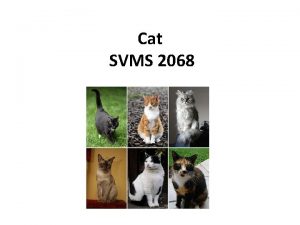Cat Classification Class r o l o C



































- Slides: 35

Cat Classification Class

? r o l o C Describe Me Bre ed? ? n r e t t Pa

What is a breed? • Each breed is characterized by specific traits: colors, shapes, body types, behaviors/personality • Each breed is only a guideline – every cat is an individual

Why are breeds important? • Help educate potential adopters • To share information: debunk myths, be more knowledgeable • To be able to identify cats by a description

HSSA Cats What do we see at HSSA? In 2018, HSSA adopted out 1353 cats. • Most popular breeds at 91. 7% Domestic Short Hair (DSH) 73% Domestic Medium Hair (DMH) 18% Domestic Long Hair (DLH) 0. 7% DSH DMH DLH

HSSA Cats • Siamese was second most popular at 5%. • Other recorded breeds, all at less than 1%: Bengal, Himalayan, Maine Coon, Manx, Persian, Ragdoll, Russian Blue and Snowshoe.

Identifying Colors Solid: All over solid color. Bi-Color: Any solid color cat plus white, with the two colors being fairly evenly distributed. With White: Any solid color or color pattern plus white markings. Generally there are distinct larger patches of white on the cat. Pastel or Dilute: A lighter version of some colors

Identifying Colors • Black cats tend to take longer to get adopted in shelters • Only 40% of White cats with blue eyes are deaf • Blue is the official name although some people refer to it as gray

Identifying Colors • All Red cats have a tabby pattern due to the non-agiouti gene • Chocolate color cats are rare due to the gene needed to produce the color • Buff cats are a dilute red – typically tabby

Is it Black & White or White & Black

Tortie or Calico Tortie with White Tortie Calico

Tabby Patterns • Tabby is a pattern that can occur in nearly every breed Classic Tabby Mackerel Tabby Ticked Tabby Spotted Tabby

Common Tabby Colors Buff/Cream Blue Brown Red Silver

Cat Eyes • All kittens have blue eyes until they are 6 -7 wks old • Siamese, Balinese, Himalayan, Persian and Ragdoll can all keep the blue eyes as adults • Heterochromia is when a cat has two different colored eyes

Abyssinian • Coats can be blue, chocolate, fawn or red • Color pattern is ticked and is caused by several different color bands on each hair shaft • Silver versions of all these colors occurs when there is white color closest to the skin

• Coats are widely varied and can range from ivory to orange to brown. • Distinctive spots or marbled patterns can also vary in color • Rosettes are unique to Bengals and refer to a spot with a darker outline

Siamese • Siamese are characterized by color “points” in their coats and blue eyes. • Colors include seal points, chocolate points, blue points, flame points and lilac points • It can take up to 3 years for the points to fully develop Seal Point Chocolate Point Flame Point Blue Point Lilac Point

• Ragdolls come in three patterns: Bi-color, Mitted and Colorpoint • Those patterns can be in six colors: Seal, Blue, Chocolate, Lilac, Red and Cream • Ragdolls are lovingly known as “puppy cats”

Persian & Himalayan • Persian coats are too numerous to name, but the brachycephalic (excessively short, “pushed in”) muzzle is a telltale trait

Maine Coon • Maine Coon cats can come in every color and pattern except they can not have points. • Distinctive tufts of hair on ears and feet • Typically weigh between 9 and 18 pounds

Manx • Manx cats can have a variety of natural tail lengths, but never full length • Characteristically round faces and eyes • Many coat colors and patterns except chocolate, lavender and pointed.

Russian Blue • Russian Blues are always blue with green eyes • Their head is wedge shaped and they have large ears • Highly intelligent and are often accused of training their owners

Sphynx • Sphynx cat is furless, but is covered in a fine down • Comes in almost every color and pattern • Frequent baths and skin care is a must

? ? ? Male or Female? ? ? • Do you know how to tell the difference between a female and a male cat? – (Hint: you gotta check their behind. )

Female Male

Trap, Neuter, Return • HSSA’s Clinic performs apx 600 TNR surgeries a year

Why TNR? • Trap, neuter, return programs are a way to humanely manage feral cats while helping to control pet-over-population and the spread of feline diseases. • Feral cats are trapped in humane traps, brought to the Humane Society of Southern Arizona for a spay/neuter surgery, ear tipping and then released back to their neighborhood, which is the cat's natural territory and his or her home.

What Are Feral Cats? • Feral cats are not stray or community cats. Feral cats are born outdoors and live without any substantial human contact. Feral cats are afraid of people; you can’t hold them or pet them, and they must be caught using a humane trap. Stray or community cats are homeless or abandoned domestic, "pet", cats.

What exactly is Declawing? • Declawing is the amputation of the last bone of each toe through scalpel, guillotine clipper, laser surgery or tendonectomy • It is equivalent to cutting off our fingers at the first knuckle • Often leads to aggressive behavior and resistance to use a litter box

What exactly is Declawing?

Cat Facts and Myths • Cats always land on their feet – Myth – while they are agile the can still be injured in a fall. They are more likely to be injured in a short fall than a long one because they don’t have the time to react • Cats cannot be trained – Myth – they can be trained to do tricks, walk on a harness and leash, and even play instruments (famous internet cat Tuna) • Cats cannot taste sweetness – Fact – they are believed to be the only mammal that cannot taste sweetness • Cats have 18 toes – Fact – five toes on each front paw and four toes on each rear paw

Cat Facts and Myths • Cats don’t need vaccines if they stay indoors – Myth – cats are exposed to germs through the owner’s clothing and family dogs bringing them inside • Cats have an extra organ – Fact – the Jacobson’s organ is in the back of their mouth that allows them to taste scents on the air, this is why they stare with their mouth open at times • Cats and pregnant women don’t mix – Fact and Myth – Fact is that cats carry a disease called Toxoplasmosis in their feces so pregnant women should never clean litter boxes. Myth is that pregnant women can still interact with cats as long as the cat is clean and free of feces • Cats without whiskers have no balance – Myth – cats use whiskers to feel things, not maintain balance

Cat Facts and Myths • Cats drink milk not water – Myth – milk can cause diarrhea and obesity in cats • Cats have 230 bones in their bodies – Fact – and they don’t have collarbones, which allows them to be flexible and graceful • Cats are stealthy – Fact – the extra thick, soft pads on their paws allow them to move in near silence • Cats should eat human food – Myth – a piece of cheese for a 10 lb cat is like a person eating 3 full size chocolate bars

Cat Facts and Myths • A group of kittens is called a kindle – Fact – and a group of cats is called a clowder or glaring • All calico cats are female – Myth – 1 in 3000 is male • 10% of a cat’s bones are in its tail – Fact – a cat has 19 to 23 vertebrae

Garfield d e R l e r e k c a M y b b a T Do me Sho stic rt H air
 Cat 1 cat 2 cat 3 aviation
Cat 1 cat 2 cat 3 aviation Cat 1 2 3 minima
Cat 1 2 3 minima I bought me a cat and the cat pleased me
I bought me a cat and the cat pleased me Cat and mouse story writing
Cat and mouse story writing Classification of a cat
Classification of a cat The science of naming and classifying organisms
The science of naming and classifying organisms Today's class answers
Today's class answers Putting a package together
Putting a package together Difference between abstract class and concrete class
Difference between abstract class and concrete class Lower class boundary of the modal class
Lower class boundary of the modal class Class i vs class ii mhc
Class i vs class ii mhc Abstract concrete class relationship
Abstract concrete class relationship What is frequency distribution
What is frequency distribution Stimuli vs stimulus
Stimuli vs stimulus Stimuli vs stimulus
Stimuli vs stimulus Therapeutic class and pharmacologic class
Therapeutic class and pharmacologic class Class maths student student1 class student string name
Class maths student student1 class student string name What is the class width for the given class (28-33)?
What is the class width for the given class (28-33)? In greenfoot, you can cast an actor class to a world class?
In greenfoot, you can cast an actor class to a world class? Static vs dynamic class loading in java
Static vs dynamic class loading in java Class 0 esd
Class 0 esd Static class diagram
Static class diagram Class 2 class 3
Class 2 class 3 Public class test subject extends test class
Public class test subject extends test class Package mypackage class first class body
Package mypackage class first class body Class third class
Class third class C++ class implementation
C++ class implementation Component class has composite class as collaborator
Component class has composite class as collaborator Beckett classification of partial denture
Beckett classification of partial denture Classification of matter class 9
Classification of matter class 9 Lazy learning and eager learning
Lazy learning and eager learning Chronological tabulation is based on
Chronological tabulation is based on Traditional classification vs modern classification
Traditional classification vs modern classification Cat selman
Cat selman Acrostic poem hockey
Acrostic poem hockey Wcu jobcat
Wcu jobcat



























































